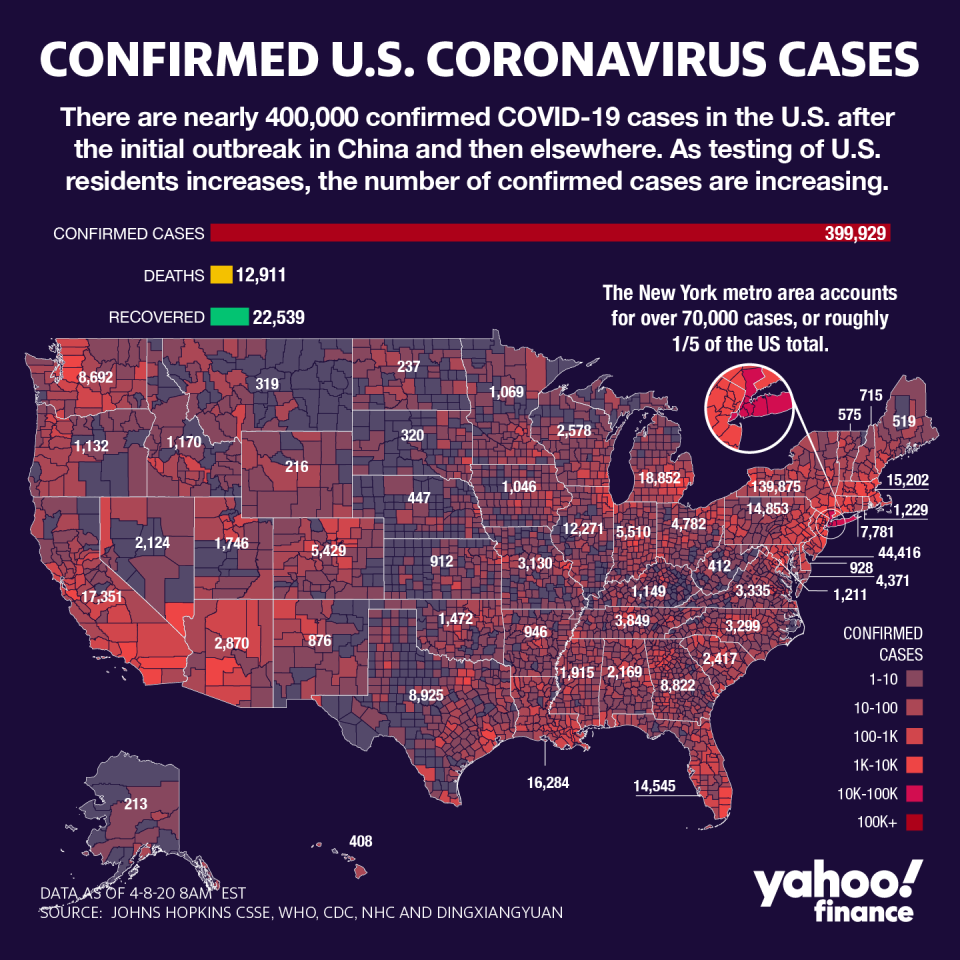Coronavirus update: US sees deadly day as spat with WHO intensifies
The U.S. on Wednesday recorded its largest spike in deaths as the coronavirus pandemic raged unchecked, with President Donald Trump’s pointed criticism of the World Health Organization triggering a rebuke from the embattled agency.
Even as investors gained confidence on a potential slowdown in new infections during a pivotal stretch of the crisis, nearly 2,000 more Americans perished between Tuesday and Wednesday. Overall, the COVID-19 virus has infected over 1.4 million people worldwide, and killed more than 83,000.
Promising news continues to come out of Italy and Spain, meanwhile Wuhan— the epicenter of the outbreak in China— emerged from its nearly three-month lockdown Wednesday.
The WHO, a branch of the United Nations, has come in for increasingly pointed questioning over whether it mishandled early warning signs, or showed favoritism to China in the process— including criticizing the U.S. travel ban on China and ignoring Taiwan. WHO officials have said deference to China was a strategy to gain access to the country.
Amid the furor — and with his re-election chances on the line— Trump has threatened to withhold funding for the agency, sparking a war of words with Director General Tedros Adhanom Ghebreyesus.
After Trump declared the WHO “really blew it” with its initial handling of the pandemic, Ghebreyesus told a news conference on Wednesday that “the focus of all political parties should be to save their people.”
He added that governments should refrain from politicizing the crisis, “if you don’t want to have many more body bags.”
‘Much flatter graph’
Currently, the U.S. leads the world with 400,000 diagnosed infections and nearly 13,000 deaths; the greatest impact is still being felt in New York City. The Empire State is struggling with over 140,000 cases and more than 5,000 deaths, and the Big Apple is closing in on 79,000 cases.
Meanwhile, Italy tops the rest of the world in deaths with more than 17,000 — but Spain is now the world’s second hottest cluster of COVID-19 infections, with more than 146,000 cases.
However, markets rallied on hopes that the worst could soon be over, even as a top public health official warned this week would be grim.
“It’s going to be a bad week for deaths,” Anthony Fauci, the director of the National Institute of Allergy and Infectious Diseases, told Fox News on Wednesday. However, he added that the U.S. should see “the beginning of a turnaround” afterward.
Despite the rise in cases and deaths, as anticipated this week by the WH task force, Dr. Deborah Birx, coordinator of the White House coronavirus task force, said the estimated impact to the U.S. is likely to come in much lower than originally expected due to social distancing efforts.
“And when you look over three days, you’re starting to see that we may be actually — in a series of communities outside of New York and New Jersey and Connecticut — (be) creating a much flatter graph,” she said.
That trend is already being seen in New York, according to Gov. Andrew Cuomo. “If we stop what we are doing, we will see that curve change. But right now, it is flattening,” he told reporters at a daily press briefing.
However, New Jersey has seen a rapid rise in new cases, which is straining local efforts to contain a surge in emergency room visits. Cases rose by 7% to 47,437, the state reported — a slight tapering of double-digit increases seen last week. However, Governor Phil Murphy reported 275 new deaths, the biggest one-day jump since the virus began hammering the state.
Newark Mayor Ras Baraka told Yahoo Finance the outbreak has been tough on a city health system that was already strained.
“People don’t understand that a lot of people in these communities use 9-1-1 as their primary care physician, so they call 9-1-1, (and) EMS, EMT gets overwhelmed,” Baraka said.
“People can’t just walk into the emergency room like they used to. So getting people used to that culture and getting used to those norms has been very difficult,” he said.

Ventilators and vaccines
As the White House works on a plan to re-open the economy, the U.S. Department of Health and Human Services (HHS) announced the Defense Production Act will result in $489 million contract for 30,000 ventilators by August from General Motors (GM).
At least 6,000 of those will be produced by June, the agency said. Yet amid concerns the ventilators will come too late to respond to the U.S. outbreak, Trump has said that other countries could potentially use the ventilators produced by GM, Ford and others.
Meanwhile, attention shifted to companies working on treatments and vaccines.Novavax (NVAX) surged Wednesday after reporting it will start clinical trials of its coronavirus vaccine in mid-May. That makes it the third company to start clinical trials early in the year.
Moderna (MRNA) was first to trials in mid-March, in a record 66 days after producing the vaccine. The company was followed by Inovio (INO), which has just begun trials this week, while Johnson & Johnson (JNJ) announced its vaccine candidate that’s expected to begin trials in September.
Anjalee Khemlani is a reporter at Yahoo Finance. Follow her on Twitter: @AnjKhem
Read the latest financial and business news from Yahoo Finance
Follow Yahoo Finance on Twitter, Facebook, Instagram, Flipboard, SmartNews, LinkedIn, YouTube, and reddit.

 Yahoo News
Yahoo News 